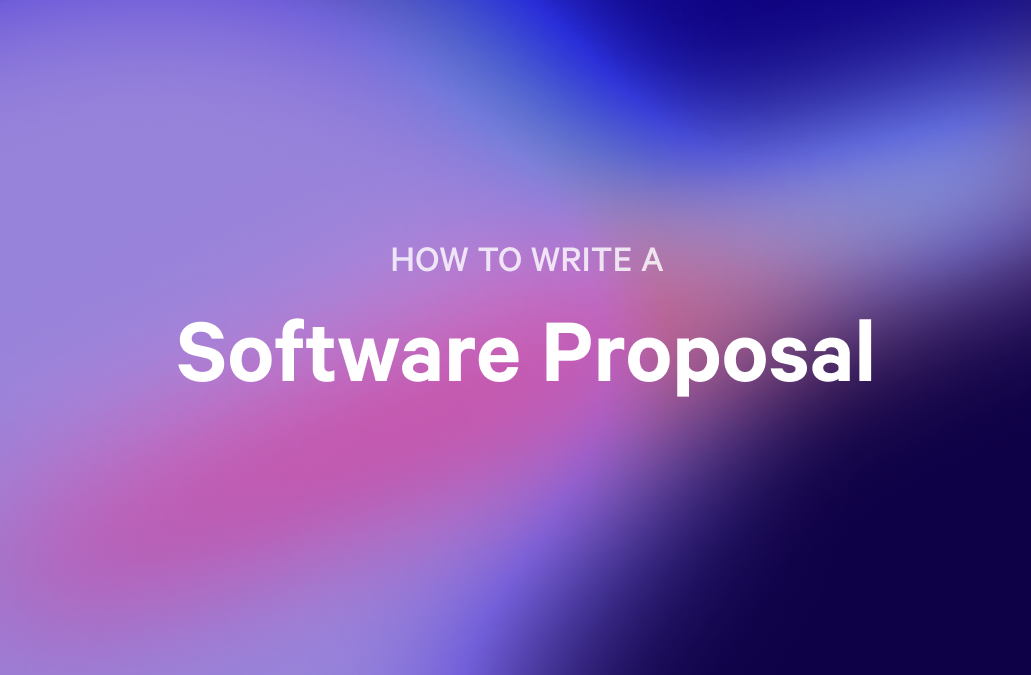Writing an accounting services proposal can be a tricky proposition for many. How can you outline the services you offer in an engaging way? How can you demonstrate your knowledge of the client's unique needs and position yourself as the ideal solution?
This guide will show you how.
From the content you need to the ideal structure and even a template you can use. We'll walk you through each part of the accounting services proposal, helping you speak directly to your client's needs while laying the foundation for a fruitful relationship. All that will be left for them to do is sign on the dotted line…
Key takeaways:
- An accounting services proposal should demonstrate a deep understanding of the client's business and financial needs.
- The proposal should clearly define the scope of services and connect each service to the client's needs or goals.
- It's important to share a solutions-based approach, showing how your service solves each problem identified.
- Including case studies and success stories can provide social proof and demonstrate your skills.
- Clearly explaining your pricing details and structure helps clients understand what they're paying for.
What is an accounting services proposal?
In an accounting services proposal, you explain who you are, what services you offer, and how you can solve the client's specific challenges. It's a bridge that connects your accounting knowledge with your potential client's particular needs and goals.
This comprehensive plan should demonstrate a deep understanding of your client's business, showing that you know where they are, where they want to go, and how to get them there.
It also paints a picture of you and your process. Are you a traditionalist who sticks to known methods? Or are you an innovator always looking for new ways to solve financial challenges? This is where your personality and professionalism come together, showing potential clients what you do and who you are.
Steps to take when writing your accounting services proposal (and key elements to include)
Creating a proposal for accounting services is like providing your clients with a roadmap to achieve financial health and success. We'll walk you through the essential steps for drafting a proposal that meets your client's needs and highlights your capabilities.
1. Learn about your client's needs
This part is about putting yourself in your customer's shoes and finding out what they need from you.
Start by immersing yourself in your client's business and financial situation. Find out what industry they're in, how big they are, where they stand compared to others in their market, and what financial challenges they face.
Are they part of a new company trying to get their finances in order? Or perhaps an older company looking for better tax strategies and savings? Knowing these things is crucial.
Take a close look at how they're currently handling their finances. What accounting services are they using? Where could they use help? Maybe they're not taking advantage of all the tax benefits they could be, or their financial statements aren't as clear as they could be. If you find these gaps, you can show how to close them with your services.
You shouldn't forget about their future goals either. If you know what your client wants to achieve later, you can make a proposal that considers their current needs AND supports their long-term goals.
2. Define the scope of your services
Here, you can show how well you can respond to your client's requirements.
Whether it's critical accounting functions, bookkeeping services, tax filings, or financial consulting, describe each area. But now comes the important part: connect each service to your client's needs or goals. For example, if you offer bookkeeping, don't just mention it. Explain how good bookkeeping gives clients a better overview of their finances and helps them make better business decisions.
Then, go into the details of the individual services. What exactly does your tax service include? Is it just filling out tax returns, or does it also include planning to make tax time more efficient? Being specific here will make it easier for your clients to understand exactly what they're getting.
3. Share your solutions-based approach
This is where you show your customers that you're a problem solver who offers solutions tailored to their needs. You aren't simply creating an accounting project proposal and telling your prospective client what services you provide; you are sharing a solution to their challenges.
You've already gained an understanding of your client's specific pain points, and now is the time to be strategic. Explain how your service solves each problem you've identified in the first step of this process. If the problem is managing cash flow, describe how your detailed accounting and forecasting can give the company a better overview of its finances. Connect the dots between the problem and your solution.
Also, don't forget to discuss the long-term benefits of your solutions. Good tax planning, for example, isn't just about solving immediate tax problems. It's also about creating a foundation for lasting financial health and complying with the law.
4. Select and include case studies and success stories
In this section, you show how your services have made a big difference for your past and current clients. Social proof tends to go a long way when people are shopping for a new service provider.
Choose a few examples that best demonstrate your skill in the accounting services you provide, especially those relevant to the clients you want to work with. For example, if you're focusing on small businesses, choose instances where you've helped other small businesses improve their financial situation.
Each case study should be easy to understand but thorough. Start with some background on the client's situation before they worked with you. Then, talk about the steps you took to help them. Have you introduced a new way of accounting or revised financial reporting? Clearly describe how you proceeded and what services you used.
And, of course, the results are the most crucial part. Use clear examples to show how successful your work was. Did you help the client save money, increase revenue, or comply with necessary regulations? These tangible results are what will really impress potential clients.
5. Present your qualifications and experience
This part isn't just for showing off your skills. It's about making your potential client feel confident in choosing you.
Start by briefly mentioning your educational background in accounting. Talk about important qualifications such as a CPA (Certified Public Accountant) or CMA (Certified Management Accountant).
Then, it's time to talk about your work experience. But don't just list the years you've worked or your jobs. Make it personal while focussing on your positive impact, especially if it matches your client's requirements.
Have you worked in the same industry as them before? Do you have special skills in tax planning or financial advice? Describe your journey, its trajectory, and the footprints you have made as you went. Telling these stories shows your client what you can do in a more immersive and engaging way.
6. Share your pricing details and pricing structure
It's essential to explain your pricing clearly.
First, talk about how you set your fees. Do you charge an hourly rate for each project, or is it a fixed monthly amount? Explain why you've chosen this method. For example, if you charge by the hour, it could be because the work varies a lot. Or if you charge a monthly fee, it could be because you do regular bookkeeping work.
Next, give more details. If you charge by the hour, what is your rate? If it's per project, how do you set the price? Is it about how complex the work is or how much time it takes? And if it's a monthly fee, what exactly does it cover? Explaining these things will help your clients understand exactly what they're paying for.
7. Set clear terms and conditions
This is the part where you outline any terms and conditions of your contract. These might include your operating hours, how many days advance notice you need to change a scheduled meeting, or the circumstances in which a client can cancel their contract.
You must also talk about how you'll protect your clients' data so they are assured you take their privacy seriously.
Last but not least, the payment terms. Explain clearly how much, when, and how you must be paid.
8. Include a CTA
Adding a call to action (CTA) is crucial when writing an accounting services proposal. It's more than "contact us." It creates a connection between your offer and the desired action of your client. Perhaps you want them to make an appointment, try a free service, or simply call sign on the dotted line. Make this step clear and simple.
So, how do you write a good CTA? Tell them clearly and directly what you want them to do next. For example, you could say, "To sort out your finances right now, sign up for a free chat by calling [phone number]." This way, you're not just giving instructions but asking them to take a helpful step.
Also, make sure your CTA is easy to recognize. Don't hide it in a pile of text. A different color or font is a good way to make it stand out.
9. Proofread and review
Proofreading means carefully reviewing your proposal for grammatical errors, typos, and sentences that don't sound right. Even small mistakes can hurt your credibility, but a little diligence here will negate this risk.
You also need to review the entire offer. Ask yourself: Is it easy to understand? Have I used too-complicated language? Is the tone of voice consistently friendly and professional? Your proposal should feel like you're explaining a complex accounting concept to a friend – accurate but easy to understand, speaking to them and not at them.
Check out our video below for a detailed walkthrough on how to create a successful business proposal starting with a Qwilr template:
Example of an accounting services proposal template
Ready to see an accounting services proposal in action? Qwilr's Accounting Service proposal template is a great, easy-to-use starting point for accountants. As well as the obvious (and not insignificant!) time-saving aspect, this template is easily customizable to both your needs and those of the clients. It presents your message in a visually impressive and brand-consistent fashion, and it can boost your conversion rates.
And did I say how easy it is to use? Ah yes. Well, some things do bear repeating…
Here is what this accounting proposal template includes:
- Introduction or Executive Summary: This part briefly explains what you'll discuss. It's professional but friendly, setting the tone for the whole proposal.
- Understanding Your (Client's) Needs: Here, you show that you know what the client is facing and what they need. It's like telling them, "We know what you're going through, and we've got your back."
- What Success Looks Like: In this section, you describe how you see the project turning out successfully. It's all about getting the client excited and confident about what's to come, painting a picture in their mind.
- 12-Month Goals: This is where you break down what you want to achieve in the first year. It's about setting realistic goals and showing the client how you'll progress.
- Our Approach: You explain your strategy for the project here. Keep it straightforward, showing your expertise without leaning too heavily on technical jargon.
- Service Overview: This part lists the services you're offering. It's a clear summary of what the client can expect, covering everything from the start to the finish of the project.
- Our Achievements: Share your past wins here, but in a humble manner. It's like telling a few success stories to show you're good at what you do and to build trust.
- Our Team: Introduce your team members here. Talk about what each person is good at, making the client feel confident they are in good hands.
- Investment Required: This part is about being open and clear with the pricing so there are no surprises later.
- Contact Us: Finish by inviting the client to get in touch. It's a friendly nudge for them to reach out and start working with you.
Takeaways
Creating an effective accounting services proposal is a great way to showcase your expertise and persuade potential clients that you are the solution to their needs. We hope this guide has helped make this tricky task that little bit easier for you!
And if you'd like a powerful, versatile, and user-friendly tool to help turn those potential clients into long-term partners, look no further than our Accounting Services proposal template.
About the author

Brendan Connaughton|Head of Growth Marketing
Brendan heads up growth marketing and demand generation at Qwilr, overseeing performance marketing, SEO, and lifecycle initiatives. Brendan has been instrumental in developing go-to-market functions for a number of high-growth startups and challenger brands.
Frequently asked questions
The best format for a proposal is a clear, concise, and visually appealing document. It should start with a professional cover letter, a summary, details of your services, pricing, case studies, and a clear call to action. Use a simple design and legible fonts, and include visuals where necessary to make the document appealing and informative.
A project proposal template can help ensure both visual appeal and that all the necessary sections are included.
To stand out, highlight your unique qualifications, specializations, and successful case studies. Use a clean, professional design that reflects the standards you bring to the work.


